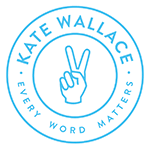Updated: April 2022
In darker moments, I worry about writing becoming obsolete.
We live in an epically visual culture. We are bombarded with more images than at any other time in human history.
And, yeah, in the cascade of the social media scroll, of email newsletters unopened, of articles quickly scanned and vacuous content by millionaire tween influencers—it’s easy to think that words and writing don’t matter.
Add in predictable headlines about our shrinking attention spans and how nobody reads anymore, and it’s enough to send a writer wringing her ink-stained hands in dismay.
Writing sometimes feels like an old-fashioned profession in our hyper-visual culture. Are scribes like me going the way of the cobbler or cooper? (That’s a barrel-maker, FYI)
Nope. We’re busier than ever.
This concern about writing going out of style is nothing new. In 1979, in a commencement speech at Syracuse University, the American journalist William Safire lamented the decline of the written word, the shrinking of attention spans to the point people wouldn’t read to the end of a paragraph, never mind an entire article.
1979! That was waaaaay pre-internet.
Safire blamed the telephone for people writing less and talking more, while TV made 20-second soundbites the norm.
The same arguments show up now, in the digital age.
I don’t buy those decline-of-writing laments. The internet has been a sneaky gift for writing in lots of ways. The acceleration of visual culture has sparked a skyrocketing of information in all its forms, including the written word.
We are producing more writing than at any other time in history. And to stand out in the online cacophony of content and copywriting, it’s more important than ever for that writing to be good. Quality matters. That’s a good thing.

Understand me: I love visuals. I’m a former arts reporter, and I love looking at things. I’m a visual learner and a visual person. But there are some things pictures and visuals just can’t do. But words can.
Good Writing Seals the Deal.
Do you ever click on the Shop Now button in Instagram? A picture has baited you: the exact satin PJs you NEED, the undereye concealer of your dreams, the enamelled cast-iron pan that does it all? (If this sounds like a peek into my consumerist desires, you’re right).
So you click.
But do you ever buy based on the image alone?
No. You read the product description and scan the reviews. You take in the taglines. And if you like the content and trust the tone? The odds are good you’ll be clicking “add to cart.”
Images are the hook. But what happens after that first glance? Brand messaging is the extra push to enter, subscribe, click, buy, whatever.
Ultimately, it’s the copy that converts.
Copy and Branding, Better Together.
A brand isn’t just a logo in the digital age. With short attention spans and the need to understand your product in milliseconds—good writing supports your brand performance and connects with your audience.
Copywriting is half the branding equation.
Photos are great for a quick-hit of personality. Once the visuals start you down a path, words become your guide, taking you deeper into an individual’s or company’s brand.
The voice in your copy should be mutually affirming to your visual identity. They rely on each other to give your audience the complete picture in seconds.
Good Writing Is a Powerful Partner.
My point? The words, the writing: they’re not superfluous. They’re the powerful partner to the visuals.
I team up with professional designers and photographers on most of my projects because our work needs each other to create connections.
I work with business owners to make sure they have a blog on their website to convince buyers before they even speak to someone from your business for the first time.

Go Deep.
What words lack in visual expediency, they can make up for in depth. Pictures are powerful but limited. Two-dimensional. Static. Bounded.
Words are unlimited in their potential.
Where a visual medium’s impact and influence end, great writing is there to do the heavy lifting of making a compelling pitch or telling us a story that builds customer connection, loyalty and maybe, just maybe, even love.
More Detail, Please.
Writing is the fine print. Literally. The calls to action. The hashtags. Heck, even images online have metatags that make them searchable. SEO runs on the words that help people find you.
For a copywriter like me, it’s my job to convey not just to your audience but also to search engines what you do and what you offer.
So the details matter more now than they ever have.
Good Writing Gives Perspective.
Sure, a picture is worth a thousand words, but whose words?
Without copywriting to accompany it, an image is open to interpretation. But combine a photo and prose, and you’ve got a power couple that can convey precisely what you want to say. Words are persuasive for everything from making a sale to crafting a winning argument for the things you care about.
So don’t let the blurred scroll get you down. Your words and your writing are more important than ever.
It’s not as hard as you think
Sometimes, it’s just a matter of getting started. So we’ve created a workbook to help you craft 15 stories about your brand that will make connecting with your audience a breeze.




Great information, Kate. You are so right. Good writing matters. Thanks for continuing to be an inspiration to more people than you may realize.
Keep up the good work Kate
Thanks, John, I will!